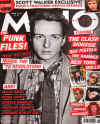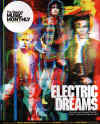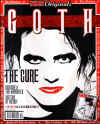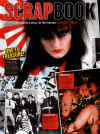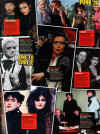|
The
Life & Loves of a She-Devil
She was Britain's first lady of punk and godmother of
goth. Nearly 30 years after forming the Banshees, SIOUXSIE SIOUX comes
clean about sex, drugs and shock tactics
"WHY'S HE ON THE COVER?" demands Siouxsie
Sioux. "Fat fool!"
"He" is Robert Smith and "the
cover" is that of Uncut's sister publication NME Originals, their
recent edition dedicated to goth. Or "goff", as the erstwhile
queen of punk snorts derisively. Maybe Siouxsie has never fully forgiven
the Cure frontman and one-time Banshees guitarist for deserting her band
on the eve of a 1984 world tour. As Smith recently told Uncut (Take 87),
he was diagnosed with chronic blood poisoning and quit on doctor's
orders. Siouxsie's having none of it.
"It wasn't like he became ill," she
complains. "He was one of those people who just didn't say 'no' to
anything, so when it's self-induced it's hard to have sympathy. To
actually say two days before a tour that's been planned in advance that
he can't do it - fuck off! What a lightweight."
Or maybe she should have been on the cover herself?
After all, this is somebody who, four years ago, came
second only to Margaret Thatcher in a Sunday Express readers' poll
nominating "The Women Who Shook The World". More than a cog in
the punk rock revolution and a heroine to virtually every 'alternative'
female singer - from makeweights like Lene Lovich and Toyah to serious
disciples such as Courtney Love, Shirley Manson and Karen 0 - if
measured by the generation of sour-faced Morticia Addams lookalikes
reeking of patchouli oil who once worshipped her every bangle, Siouxsie
is a genuine icon.
"I never could handle that," she says today.
"It was frightening. Even shop dummies were starting to look like
me. Everywhere I went there'd be bloody windows full of Siouxsies."
Now 47, she has the natural grace of a Hollywood vamp,
something she could only achieve in her youth via an Egyptian death mask
of Max Factor. The way she greets Uncut is pure 'Ice Queen', regal and
stiff, but later, curled up on a sofa beside a crackling fire in a west
London hotel, she becomes seductive, warmer. "I try to be as honest
as I can," she purrs. Which proves very much the case.
BEFORE SHE BECAME Siouxsie, she was Susan Ballion,
born May 27,1957. The youngest of three children, even from birth her
predisposition towards the exotic seemed inevitable - her parents, a
"snake doctor" and a bilingual secretary, had met in the
Belgian Congo. She was raised in the middle-class suburb of Chislehurst,
Kent, a place she describes as "knee-deep in wankers". When
she was eight, she faked suicide "to get noticed by my
parents". Aged nine, she and a friend were sexually assaulted by a
stranger. Her alcoholic father died when she was 14. At 15, she
developed ulcerative colitis, a life-threatening illness requiring that
her innards be exposed through stitches in her stomach for several weeks
until it was safe to re-insert them. "It sounds horrific," she
says, "and it was. Surreal. It completely de-romanticised the body
for me."
While recuperating in hospital, she saw David Bowie
perform "Starman" on Top Of The Pops. By the time she
recovered, she'd fully embraced glam as a refuge from wanker-infested
Kent.
It was at a Roxy Music gig in 1975 that she met future
partner and Banshees bassist Steve Severin (born Steve Bailey, nicknamed
"Spunker") who would later introduce her to The Sex Pistols.
By the spring of '76, Siouxsie (as she was now calling herself in homage
to the Native American Sioux tribe), Severin and a gaggle of glam-dram
poseurs from suburban Kent, famously christened "The Bromley
Contingent" by Melody Maker journalist Caroline Coon, had become
the Pistols' ubiquitous front row.
"What people don't understand is when punk
started it was so innocent and not aware of being a phenomenon,"
she says. "The major participators didn't know they were the major
players. I mean, the 100 Club Punk Festival wasn't sold out. The venues
that the Pistols played weren't sold out. Not many people saw them. Punk
was a minority thing."
Pistols manager Malcolm McLaren was quick to recognise
the Bromley Contingent's aesthetic potential. These were arrogant
youths, stylish, brash and sexually extrovert. Siouxsie herself would
attend Pistols shows in a cut-out bra exposing her tits, staged her own
"Sex Olympics" at a debauched house party and took gay friend
"Berlin" to the pub on a leash. She was kicked out for
requesting "a bowl of water for my dog". More contentious
still, at a time when NF membership was on the increase, the Bromley
Contingent opened up punk's wardrobe to Nazi chic. For much of 1976,
Siouxsie wore swastika armbands in an attempt to enrage the
Establishment's 'we fought a war for the likes of you' mindset. She
succeeded, though today her naivety- what NME's Julie Burchill decried
as "making a fashion accessory out of the death of millions of
people"-seems unforgivable. Siouxsie is surprisingly frank, if
unrepentant.
"The culture around then," she explains,
"it was Monty Python, Basil Fawlty, Freddie Starr, The Producers-
'Springtime For Hitler'." She kicks out her leg in a mock
goosestep. "It was very much Salon Kitty. It was used as a glamour
thing. And you know what?" she sighs." I have to be honest but
I do like the Nazi uniform. I shouldn't say it but I think it's a very
good-looking uniform."
You shouldn't say it for fear of upsetting the PC mob?
"Yeah. It's almost like you feel like saying,'Aw,
come on. Nazis - they're brilliant.' Political correctness becomes
imprisoning. It's very - what's the word? It's being very Nazi! It's
ironic but this PC-ness is so fucking fascist. In America they're
especially touchy about Nazis and it's so Nazi! You go to LA and it's so
segregated. It's very Nazi and the irony is they don't get it. They
don't realise how Nazi they are about taking offence to mentioning the
word Nazi."
The swastika was still on Siouxsie's arm on September
20,1976, the day she made her singing debut after cajoling McLaren into
letting the band she'd only tentatively started with Severin fill a
vacant Pistols support slot on the first night of the 100 Club Punk
Festival. Listed as "Suzie [sic] & The Banshees" (after
the 1970 Vincent Price chiller Cry Of The Banshee), their hastily
assembled line-up featured future Adam Ant guitarist Marco Perroni and,
on drums, the man who claimed he'd invented the pogo "so I could
knock over the Bromley Contingent" - Sid Vicious.
"He only said that in hindsight," Siouxsie
insists. "That's Sid being Sid later on when he was in the Pistols.
Look what happened to him. He got into smack. That was very un-Sid if
you'd known Sid. That's irrelevant, because we knew him and he was happy
to play with us."
They were going to "ruin" The Beatles'
"She Loves You" or the signature tune to Captain Scarlet, but
after one rehearsal chose a 20-minute "Sister Ray"-style dirge
based around "The Lord's Prayer". Later immortalised on 1979's
Join Hands, their mythically shambolic performance convinced Sioux and
Severin that they a had long-term potential. Unfortunately, with Sid
busy with his own group, The Flowers Of Romance, and Perroni deemed
incompatible, it would be five months before a remodelled Banshees
played again.
The 100 Club gig increased Siouxsie's infamy in the
music weeklies, beating The Slits' Ari-Up and X-Ray Spex's PolyStyrene
to the position of female Rotten, but it was her supporting role in the
historic Bill Grundy TV interview of December 1,1976 that would give her
column inches in the tabloids. McLaren invited four of the Bromley
Contingent - Sioux, Severin, Simone Thomas and Simon Barker - to form a
decorative backdrop for a live Pistols Q&A session. Even the
notorious svengali didn't anticipate the ensuing eruption of filth and
fury.
"It backfired on him terribly," smiles
Siouxsie. "He couldn't handle it. Which serves him right. If you
bring all these elements in and you think you can control them, then
you're the biggest fool."
The swearing had already begun before Siouxsie,
pinging her braces in Bobby Ball fashion in a white clown-face, coyly
told the drunken host, "I've always wanted to meet you." When
Grundy lecherously proposed, "We'll meet afterwards, shall
we?" the Pistols' guitarist Steve Jones let rip. "You dirty
bastard. You dirty fucker. What a fuckin' rotter!"
"It's been scrutinised so much," she says,
"but there's not much to it, really. It's funny that it's become
some kind of pinpoint moment because if you look back at it, it's so
tame. When you think about the response of people kicking their TV sets
in and moaning, 'That was disgraceful!' IT WASN'T! The actual day was
just us thinking, 'Let's have a laugh.' Free sandwiches and free booze
in the green room. The best thing was afterwards, they still didn't know
what to do with us so we went back in the green room when all the phones
started ringing. The switchboard had overloaded with calls from people
complaining. There'd be me or Steve Jones running around pissed,
answering these phones and shouting 'Oh, fuck off, you stupid
c***!"'
For Siouxsie, finding herself on the cover of The
Daily Mirror under the headline "Siouxsie is a punk shocker!"
marked the depressing end of a glorious era.
"I didn't relish or enjoy it," she says now.
"I realised quickly this was ridiculous and they were going to make
it what they wanted it to be - a cartoon. It was over by '77 'cos the
Bill Grundy thing killed it. They got hold of it and made it a freakshow."
BY THE TIME the Pistols, now with Vicious, released
Never Mind The Bollocks the following November, a regrouped Siouxsie
& The Banshees had already established a loyal club following. Early
songs like "Bad Shape" ("We're all fucking spastics/
We're all paralysed") and "Carcass" (often dedicated to
the recently deceased Elvis) seemed the logical expression of Sioux's
"de-romanticising" of the body. New drummer Kenny Morris and
guitarist John McKay were played the soundtracks to The Omen and Psycho
as a pointer to Siouxsie's musical direction.
"I just wanted something with a slight
disturbance," she explains. "I still thought what we were
doing were pop songs. In the way that John Leyton's 'Johnny Remember
Me', where the backing vocals are the ghost of the woman that's died,
and 'Terry' by Twinkle, were pop songs. I loved death pop."
Galvanised by two John Peel sessions and an errant
roadie's "Sign The Banshees" graffiti campaign sprayed or
carved upon the brickwork of various major label offices, they finally
accepted a deal with Polydor in spring '78. In spite of their
"death pop" agenda, debut single "Hong Kong Garden"
was deliriously catchy Geisha punk. Taking its title from a Chislehurst
Chinese takeaway, its lyrics stemmed from Siouxsie's teenage anger at
the racial abuse the oriental staff suffered from local bootboys.
"I remember wishing that I could be like Emma
Peel from The Avengers and kick all the skinheads' heads in," she
seethes, "because they used to mercilessly torment these people for
being foreigners. It made me feel so helpless, hopeless and ill."
Those who assisted "Hong Kong Garden" to No
7 in the UK chart were to be shocked if they expected the same from the
LP that followed. Sandwiched between Magazine's Real Life (five months
earlier) and PiL's Public Image (one month later), The Scream was the
second in a triptych of '78 debuts marking the moment punk went
"post". Against McKay and Severin's brutal riffs, Sioux's
claustrophobic dramas of rotting flesh and suburban relapses took
"No Future" nihilism to hitherto unfathomed depths.
It remains an extraordinary and uncompromising work.
On its release, however, Sioux's nemesis at the NME, Julie Burchill,
ignored the fact that the Teutonic death march "Metal
Postcard" was dedicated to anti-Nazi propaganda artist John
Heartfield and mounted a belated attack on Siouxsie's swastika phase.
"Siouxsie is well into her twenties," wrote Burchill, "so
ignorant youth is no excuse. Therefore she must be either evil or
retarded."
Was it mutual hatred between her and Burchill?
"I've never met her," she says. "The
way I saw it, it was an excuse. She didn't want to like us. It's plain
old envy. Must be." She sniffs. "Fat old cow."
What about the accusation of anti-Semitism? Come on,
there was that original lyric in "Love In A Void": "Too
many Jews for my liking"...
"That was a Severin lyric."
You sang it.
"Yeah, I sang it, but I took it as it was meant,
as 'skinflints'. Obviously a lot of people didn't get it that way, so it
was changed."
Sadly, not in time to prevent the Far Right from
claiming Siouxsie as one of their own. Dismayed by the NF's attendance
at gigs, she resorted to wearing a Star of David T-shirt as a middle
finger to the BNP.
At least she had admirers at NME to counterbalance
Burchill's scorn, specifically Paul Morley, who would later pen gushing
sleevenotes for 1981 's singles collection Once Upon A Time. Rumour has
it that, midway through an early NME interview, Morley and Siouxsie
interrupted proceedings to get down to something more intimate than
journalistic banter. Is this true? For once, she's speechless.
"Oooooh!" she eventually whoops. "No
comment!"
You don't want to deny or confirm it?
"No," she smirks. "I like
rumours."
THE BANSHEES' career could have very easily ended on
September 7,1979, the day that a disgruntled Morris and McKay absconded
prior to that evening's gig in Aberdeen. Siouxsie's feelings on the
matter would later be expressed on "Drop Dead Celebration",
the B-side of "Happy House", which carried the sinister
run-out groove inscription "Bye Bye Blackheads". Reviewing the
single in NME, Uncut's Roy Carr deemed it "one of the most venomous
putdowns ever recorded".
"I love that song," Siouxsie enthuses.
"It's such a 'Fuck you!' But then again, if John and Kenny hadn't
walked out, I'd never have met my husband."
Sioux and Severin had ceased being lovers by the time
former Slits drummer Peter Clarke, alias Budgie, joined the Banshees,
barely a week after the Aberdeen debacle. Budgie's relationship with
Siouxsie blossomed furtively ("I didn't want us being a couple to
affect the group spirit"), though by 1981 's "Mad Eyed
Screamer", the first release from their side project as The
Creatures, the couple's mutual infatuation was obvious. They finally
married 10 years later.
Meantime, the Banshees had become, in Siouxsie's own
words, "almost a different group". After Budgie came former
Magazine member John McGeoch. The late guitarist's eerie, exotic playing
style gave the sound psychedelic, even gothic, overtones. With 1980's
"Happy House" and "Christine" (which, like its flip
"Eve White/Eve Black", was a homage to the real-life split
personality who inspired The Three Faces Of Eve, Christine Sizemore),
the Banshees became a commercially successful UK pop act without
alienating an audience that would soon epitomise the '80s alternative
rock scene.
In 1982, during sessions for A Kiss In The Dreamhouse,
still regarded by many critics as the Banshees' finest hour, Siouxsie
awoke to McGeoch's alcoholism. "We all over-drank," she
admits, "but he seemed to go further and sink deeper. With the rest
of us, drinking was a phase. With him it was an illness."
Weren't you doing a lot of drugs at that time?
"I've never been interested in heroin. There's no
way I want to resemble a slob. I find smack just - euch!- revolting. I
like fun and I like 'up'. I loved LSD,yes. But you can't get the good
stuff like you used to. I remember when ecstasy came in. Not as good.
You used to get very pure LSD, and I'm sure even that stuff wasn't half
as good as it was in the '60s. Blue Window Pane is great. I've had
Purple Haze, too."
Ever had a bad trip?
"No. Never. I've always had an amazing time. In
fact, it was because somebody tried to scare me and said, 'You don't
want to take LSD, it'll make you freaky, it'll drive you mad,'that I
went, 'Sounds good!' I have a theory that the people who have a bad time
are the people that lie to themselves so they end up looking in the
mirror and going,'Aargh!'You can't hide with LSD. It's a truth
drug."
The increasingly unreliable McGeoch was eventually
sacked. He died in March 2004, a passing Siouxsie sombrely describes as
"simply devastating". He was replaced by The Cure's Robert
Smith, whose first Banshees record, an excessively trippy cover of The
Beatles'"Dear Prudence", went Top 3 in October 1983. It would
be the Banshees' biggest hit, though more would follow before their
split some 12 years later, including "Cities In Dust" and
"Face To Face", co-written with Danny Elfman for Batman
Returns.
With Severin no longer in the frame after 2002's
reunion tour ("I don't hate him," she says of their
relationship, "I've just given up trying to work with him"),
today the Banshees moniker is officially defunct, although Siouxsie and
Budgie, who today live in the south of France with their cats, continue
to perform their material with a new backing band.
Following the Banshees B-sides box set Downside Up,
next year sees the first solo Siouxsie album. It would have been out
already had she not quit smoking and developed an allergy that left her
in hospital "with two super-size tampax up my nose". There was
a risk she'd never sing again, but she fought back and rediscovered her
voice. "Adverse conditions bring out the best in me," she
cackles. "So that's why you can't get rid of me. What people have
to do is make it really nice for me, give me lots of money, put me on TV
all over the place. Give me luxury, and then I might give up."
(Side boxes)
Severed Alliance
When Mozzer met Siouxsie
IN 1993 SIOUXSIE received an invite from Morrissey to
duet on a cover of "Interlude", a late-'60s ballad originally
sung by Timi Yuro. Released as a one-off single the following year,
Morrissey and Siouxsie fell out dramatically over discussions for an
accompanying video.
"I'd always liked him, not particularly for his
material, but because he was a personality that didn't fit into any
pigeonhole," explains Siouxsie. "I'd been living in France so
I had no idea, until Severin told me, that he'd been doing stuff with
the Union Jack. I hate nationalism, that over-the-top British thing. The
original video idea was to show Ruth Ellis being led to the gallows,
which I loved, but which didn't happen. Instead he wanted a bulldog,
which I didn't understand. Why a bulldog? So I questioned him about his
pro-British thing and told him I couldn't have that. I said, 'Pick
another dog, like a Chihuahua or something. A monkey. Anything!' That's
all it was about, really. But the principle was that he wanted to go
along with that imagery. I don't know why he wanted to stick to his guns
so much. And, no, we've not spoken since."
Fireworks
The essential Siouxsie & The Banshees
THE SCREAM 1978 *****
Julie Burchill never got it, but the Banshees' debut
remains one of the most fiercely original LPs of the post-punk era. All
suburban frustration and sonic chaos, the highlights include a Satanic
attack on the The Beatles' "Helter Skelter".
JUJU 1981 ****
The voodoo artwork unintentionally cemented their goth
reputation, but with Budgie and McGeoch warmed up after the previous
year's Kaleidoscope, it was on Juju that the classic Banshees sound
finally gelled, typified by the mystic psych-pop of
"Spellbound".
ONCE UPON A TIME 1981 *****
A necessary singles roundup from "Hong Kong
Garden" to "Arabian Knights" via such radio-unfriendly
nerve jangles as "The Staircase (Mystery)" and
"Playground Twist". Side 2's near immaculate run ("Happy
House", "Christine", "Israel", the Juju
singles) finds the Banshees hitting peak after peak.
A KISS IN THE DREAMHOUSE 1982 *****
Inspired by the woozy psychedelia of The Beatles'
White Album and Siouxsie's discovery of recreational LSD, the Banshees'
fifth was a sensual affair. The sexy "Slowdive" even suggested
a band not adverse to the disco. Beyond goth.
TWICE UPON A TIME 1992 ****
"There might be other groups but this is the one
that matters," wrote Uncut's Jon Wilde in the sleevenotes of this
second singles compilation, covering '82 to '92. A beguiling blend of
hits and misses.
All titles available on Polydor CD
Simon Goddard 01/05
BACK
TO INTERVIEWS/ARTICLES INDEX
|
